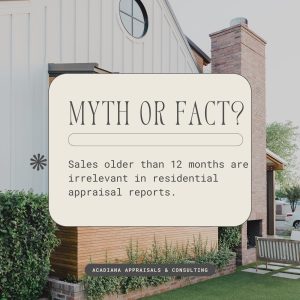Are older stales still relevant in residential appraisal reports? The answer isn’t as simple as black and white. In this article, we’ll explore the nuances of using older sales in appraisals and debunk the common misconceptions surrounding their validity. By the end, you’ll have a clearer understanding of how to navigate the complexities of including older comparables for accurate valuations.
While the Uniform Standards for Professional Appraisal Practice (USPAP) does not require comparables to be within a specific time frame, agencies like Fannie Mae and FHA require at least three comparables within 12 months of the valuation date. However, there is no prohibition against using older comparables, as they can contribute to “credible assignment results,” as stated in the guidelines. The guidelines from FHA specifically state “The Appraiser must include as many comparable properties as are necessary to support the Appraiser’s analysis and conclusion. At a minimum, the Appraiser must include the most recent and relevant sales, preferably within the last six months. The Appraiser must include at least three sales that settled no longer than 12 months prior to the effective date of the appraisal. The Appraiser must provide additional support by including more sales, offerings, offerings now under contract, or relevant sales that settled more than 12 months prior to the effective date of the appraisal.” Fannie Mae’s guidance states “Comparable sales that have closed within the last 12 months should be used in the appraisal; however, the best and most appropriate comparable sales may not always be the most recent sales. For example, it may be appropriate for the appraiser to use a nine month old sale with a time adjustment rather than a one month old sale that requires multiple adjustments. An older sale may be more appropriate in situations when market conditions have impacted the availability of recent sales as long as the appraisal reflects the changing market conditions. Additionally, older comparable sales that are the best indicator of value for the subject property can be used if appropriate. For example, if the subject property is located in a rural area that has minimal sales activity, the appraiser may not be able to locate 3 truly comparable sales that sold in the last 12 months. In this case, the appraiser may use older comparable sales as long as they explain why they are being used.”
The Relevance of Older Sales
Using older sales doesn’t necessarily undermine the reliability of an appraisal report. in certain cases, the most appropriate comparable might be a property sold 12, 24, or even 36 months ago, particularly when dealing with complex properties. Just like other factors such as living area, site size, and condition, variations in the sale dates may require adjustments to comparables sold in the most distant past.
Market Condition Adjustments
If property values have shifted since the comparable sale, a market condition adjustment should be employed. For instance, if we consider a comparable sale from three years ago, it would likely require a positive adjustment due to the prevailing upward trend in property values within our market. However, it’s important to remember that submarkets can exhibit unique behaviors and trends. While the overall market may follow a certain pattern, it doesn’t imply uniformity across all submarkets.
Segmented Market Analysis
To illustrate this point, let’s consider properties in Upper Lafayette aged between 20-40 years with 1200-1600 square feet of living area on quarter-acre plots. These properties may appreciate at a different rate compared to 6-15 year-old properties in South Lafayette, which have 2800 to 3400 square feet of living area on 1-2 acre plots. Therefore, it’s crucial to consider the specific market segment of the property rather than relying solely on the overall market when making market condition adjustments.
Considering Recent Sales
Conversely, when appraising a standard property in a subdivision that had 50 sales in the past year, it may not make sense to include sales older than 12 months, or even six months. In such cases, recent sales typically offer a more accurate value indicator, provided they are comparable in other ways.
Analyzing Nearby Subdivisions
When options are limited within the subject property’s subdivision, using sales from nearby subdivisions requires thorough analysis. Making assumptions about the applicability of these sales could lead to skewed valuations. Differences in site value, quality, and condition must all be taken into account, and every comparable should be scrutinized for difference from the subject property, necessitating adjustments for an accurate valuation.
Conclusion
The validity of using older sales in residential appraisal reports is a nuanced matter. While there are no strict rules, understanding the market dynamics and the specific property segment is crucial for accurate appraisals. By carefully analyzing and adjusting comparables from both the past and recent sales, appraisers can provide reliable and insightful reports that reflect the true value of a property.

